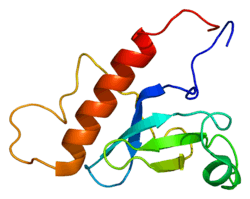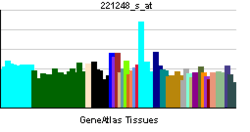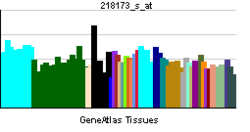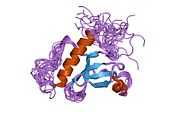WHSC1L1
| Wolf-Hirschhorn syndrome candidate 1-like 1 | |||||||||||||
|---|---|---|---|---|---|---|---|---|---|---|---|---|---|
 PDB rendering based on 2daq. | |||||||||||||
| |||||||||||||
| Identifiers | |||||||||||||
| Symbols | WHSC1L1 ; NSD3; pp14328 | ||||||||||||
| External IDs | OMIM: 607083 MGI: 2142581 HomoloGene: 56960 GeneCards: WHSC1L1 Gene | ||||||||||||
| EC number | 2.1.1.43 | ||||||||||||
| |||||||||||||
| RNA expression pattern | |||||||||||||
 | |||||||||||||
 | |||||||||||||
| More reference expression data | |||||||||||||
| Orthologs | |||||||||||||
| Species | Human | Mouse | |||||||||||
| Entrez | 54904 | 234135 | |||||||||||
| Ensembl | ENSG00000147548 | ENSMUSG00000054823 | |||||||||||
| UniProt | Q9BZ95 | Q6P2L6 | |||||||||||
| RefSeq (mRNA) | NM_017778 | NM_001001735 | |||||||||||
| RefSeq (protein) | NP_060248 | NP_001001735 | |||||||||||
| Location (UCSC) | Chr 8: 38.13 – 38.24 Mb | Chr 8: 25.6 – 25.72 Mb | |||||||||||
| PubMed search | |||||||||||||
Histone-lysine N-methyltransferase NSD3 is an enzyme that in humans is encoded by the WHSC1L1 gene.[1][2]
This gene is related to the Wolf-Hirschhorn syndrome candidate-1 gene and encodes a protein with PWWP (proline-tryptophan-tryptophan-proline) domains. The function of the protein has not been determined. Two alternatively spliced variants have been described.[2]
The WHSC1L1 gene is amplified in several cancers,including lung cancer and head and neck cancer, and may play a role in carcinogenesis.[3][4]
References
- ↑ Stec I, Nagl SB, van Ommen GJ, den Dunnen JT (Jun 2000). "The PWWP domain: a potential protein-protein interaction domain in nuclear proteins influencing differentiation?". FEBS Lett 473 (1): 1–5. doi:10.1016/S0014-5793(00)01449-6. PMID 10802047.
- ↑ 2.0 2.1 "Entrez Gene: WHSC1L1 Wolf-Hirschhorn syndrome candidate 1-like 1".
- ↑ Kang, D; Cho, HS; Toyokawa, G; Kogure, M; Yamane, Y; Iwai, Y; Hayami, S; Tsunoda, T; Field, HI; Matsuda, K; Neal, DE; Ponder, BA; Maehara, Y; Nakamura, Y; Hamamoto, R (Feb 2013). "The histone methyltransferase Wolf-Hirschhorn syndrome candidate 1-like 1 (WHSC1L1) is involved in human carcinogenesis.". Genes, chromosomes & cancer 52 (2): 126–39. doi:10.1002/gcc.22012. PMID 23011637.
- ↑ Chen, Y; McGee, J; Chen, X; Doman, TN; Gong, X; Zhang, Y; Hamm, N; Ma, X; Higgs, RE; Bhagwat, SV; Buchanan, S; Peng, SB; Staschke, KA; Yadav, V; Yue, Y; Kouros-Mehr, Hosein (2014). "Identification of Druggable Cancer Driver Genes Amplified across TCGA Datasets.". PLoS ONE 9 (5): e98293. doi:10.1371/journal.pone.0098293. PMC 4038530. PMID 24874471.
Further reading
- Angrand PO, Apiou F, Stewart AF et al. (2001). "NSD3, a new SET domain-containing gene, maps to 8p12 and is amplified in human breast cancer cell lines.". Genomics 74 (1): 79–88. doi:10.1006/geno.2001.6524. PMID 11374904.
- Stec I, van Ommen GJ, den Dunnen JT (2001). "WHSC1L1, on human chromosome 8p11.2, closely resembles WHSC1 and maps to a duplicated region shared with 4p16.3.". Genomics 76 (1–3): 5–8. doi:10.1006/geno.2001.6581. PMID 11549311.
- Rosati R, La Starza R, Veronese A et al. (2002). "NUP98 is fused to the NSD3 gene in acute myeloid leukemia associated with t(8;11)(p11.2;p15)". Blood 99 (10): 3857–60. doi:10.1182/blood.V99.10.3857. PMID 11986249.
- Strausberg RL, Feingold EA, Grouse LH et al. (2003). "Generation and initial analysis of more than 15,000 full-length human and mouse cDNA sequences". Proc. Natl. Acad. Sci. U.S.A. 99 (26): 16899–903. doi:10.1073/pnas.242603899. PMC 139241. PMID 12477932.
- Ota T, Suzuki Y, Nishikawa T et al. (2004). "Complete sequencing and characterization of 21,243 full-length human cDNAs". Nat. Genet. 36 (1): 40–5. doi:10.1038/ng1285. PMID 14702039.
- Gerhard DS, Wagner L, Feingold EA et al. (2004). "The status, quality, and expansion of the NIH full-length cDNA project: the Mammalian Gene Collection (MGC)". Genome Res. 14 (10B): 2121–7. doi:10.1101/gr.2596504. PMC 528928. PMID 15489334.
- Tonon G, Wong KK, Maulik G et al. (2005). "High-resolution genomic profiles of human lung cancer". Proc. Natl. Acad. Sci. U.S.A. 102 (27): 9625–30. doi:10.1073/pnas.0504126102. PMC 1160520. PMID 15983384.
- Kim SM, Kee HJ, Eom GH et al. (2006). "Characterization of a novel WHSC1-associated SET domain protein with H3K4 and H3K27 methyltransferase activity". Biochem. Biophys. Res. Commun. 345 (1): 318–23. doi:10.1016/j.bbrc.2006.04.095. PMID 16682010.
| |||||||||
